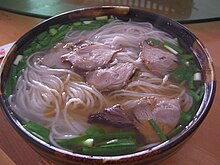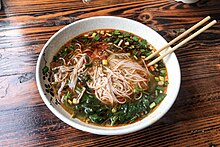Mixian (noodle)
This article relies largely or entirely on a single source. (June 2020) |
 | |
| Type | Chinese noodles |
|---|---|
| Place of origin | China |
| Region or state | Yunnan |
| Main ingredients | Non-glutinous rice |
| Variations | Ganjiang mixian, suanjiang mixian |
Mixian (simplified Chinese: 米线; traditional Chinese: 米線; pinyin: mǐxiàn) is a type of rice noodle from the Yunnan Province, China. These noodle are typically distinguished by their round shape, moderate thickness, and smooth, silky texture. They are normally used fresh and are commonly seen in stir-fry recipes, often served with rich broths and sauces.[1]
Similar to glass noodles, rice noodles differ notably in texture. As the Traditional Chinese culinary texts, such as shícì (Chinese: 食次), refer to rice noodles as "càn" (Chinese: 粲). They are commonly called "sour pulp rice noodles" (Chinese: 酸浆米线), "sour noodles" (Chinese: 酸粉), "dry rice noodles" (Chinese: 干米线), and "rice noodles"(Chinese: 米粉). Rich in carbohydrates, vitamins, minerals, and enzymes, rice noodles cook quickly, evenly, and maintain their firmness when boiled, making them suitable for hot pot and casual dining.[2]
The Crossing-the-bridge noodles (pinyin:guò qiáo mǐ xiàn) are the most popular way to eat Mixian.
Historical Development
[edit]The term "粲" in shícì, an ancient Chinese culinary book, is thought to originate from the term "精米" (jīngmǐ, or refined rice), representing finely crafted dishes. <齐民要术> (QímínYàoshù), a classical Chinese agricultural text, describes the preparation of “粲”: glutinous rice is ground into a fine powder, mixed with honey and water, and extruded through a perforated bamboo utensil, forming fine strands which are then boiled in oil. This meticulous process, which produced delicate rice noodles, contributed to the honorific term "粲."
In the Song Dynasty, rice noodles, also known as "米缆" (rice cords), were crafted into dry, silken strands suitable for gifting. The poet Chen Zao described these noodles as "one hundred feet long, thin as silk," indicating the artisanal finesse achieved during this period. By the Ming and Qing dynasties, the dish was called "米糷" (mǐlàn), with varied recipes documented, including one with finely milled glutinous rice and another with rice flour paste, seasoned with pepper, soy sauce, and green onions.
Folklore of Mixian
[edit]Crossing the Bridge Rice Noodles' is believed to have originated over a century ago in Mengzi County, southern Yunnan, China. According to local legend, the dish was created by the wife of a scholar named Yang, who would study at a pavilion on South Lake in Mengzi. Focused on his studies, Yang often neglected his meals, causing the food to go cold, which affected his health.
To keep his meals warm, Yang’s wife used a clay pot to prepare chicken soup, which retained heat effectively. She discovered that a layer of chicken fat on the soup’s surface helped insulate the broth, keeping it warm. She then added rice noodles, vegetables, and thin slices of meat to the hot broth, allowing them to cook quickly and remain hot for her husband’s meal.
This method of preparation became known as 'Crossing the Bridge Rice Noodles,' named after the small bridge that Yang’s wife crossed to bring the meal. Over time, the dish gained popularity as chefs in Yunnan further refined and adapted it, and it eventually became a renowned specialty in southern Yunnan, recognized both within China and internationally.[3]
Modern Rice noodle Production
[edit]Modern rice noodle production, particularly in Yunnan, utilizes two main methods. The traditional “sour pulp rice noodles” are made from fermented rice, yielding noodles that are resilient, smooth, and slightly sweet, with a unique rice aroma. The second, faster method uses rice flour extruded through a machine to create "dry rice noodles," which are easy to store and transport. Once dehydrated, dry rice noodles are ideal for quick meals and retain a firmer, chewable texture compared to their sour pulp counterparts.
Mechanization has differentiated rice noodles from similar products, particularly "Mifen" (Chinese: 米粉; rice vermicelli), commonly produced in southern China with additional ingredients like sweet potato or potato starch, giving them a softer texture and distinct storage properties. The texture of rice noodles, especially sour pulp noodles, is resilient and chewy, while "Mifen" is smoother and more tender.
In contemporary Chinese cuisine, “dry rice noodles” resemble Mifen in preservation techniques, facilitating long-term storage without spoilage. However, dry rice noodles are uniquely made from pure rice, unlike Mifen, which is more flexible in its composition. In regions like Yunnan, rice noodles maintain a distinct identity, whereas rice vermicelli found elsewhere evolved from rice noodles, showcasing both preservation of tradition and regional culinary innovation.
Nutritional Value
[edit]High-quality Mixian provide essential nutrients such as minerals, carbohydrates, vitamins, and enzymes. They are easy to cook, evenly textured, and resistant to overcooking. When combined with various veggies, meats, and eggs, they become even more healthful and tasty. The combination with spicy broth enriches their flavor while remaining easy to digest, making them appropriate for quick meals or fast food consumption.
Rice noodles provide essential energy from starch, which helps with brain function, and their dietary fiber encourages healthy digestion. They also help to conserve body protein and have a warming effect on the stomach, which is beneficial for easing stomach cold symptoms. They are also helpful for spleen and stomach, helping with illnesses like indigestion. Although rice noodles lose some nutrients when soaked, mixing them with a variety of seasonings helps to preserve their nutritional value and flavor.[4]
Serving
[edit]Mixian is served in various ways, either in broth or stir-fried.
Stir-fried
[edit]Stir-fried preparation is rapid, most common in the evening, and is popular at roadside barbecue-type stands throughout Yunnan. Egg, tomato, meat, spring onion and chilli are frequently utilized.

Broth
[edit]
Condiments vary significantly but may typically include some subset of the following:
- chicken powder or essence
- chili pepper (diced fresh chili, plus at least one or two prepared chilli pastes, often mixed with oil)
- chrysanthemum flowers
- coriander
- mint
- garlic (often finely diced, in liquid suspension, or in thin sectioned slices)
- ginger (as above, but less commonly in slices)
- pepper (both regular pepper and powdered or whole Sichuan pepper)
- salt
- sesame oil
- Sichuan pepper oil
- soy sauce
- spring onion
- suan cai (pickled or preserved vegetable)
- tomato
- vinegar
- wood ear mushroom
- zhe'ergen (a spicy root common to southwestern China).
Varieties of Rice Noodle Dishes
[edit]Mixian can be cooked in a variety of ways, yielding dishes such as hot and spicy soup noodles, cold rice noodles served in the summer, and stir-fried noodles. Each preparation style provides a unique flavor style. The following is an overview of some of the most popular types of Mixian rice noodles.
Crossing-the-Bridge Rice Noodles
[edit]Crossing-the-Bridge Rice Noodles is a popular Yunnan, China delicacy with a lengthy history. Its preparation is unique: a rich broth prepared from chicken, pork bones, ham, and duck serves as the foundation. Raw rice noodles are then added to the boiling broth and cooked, followed with veggies and seasonings. The recipe is finished by adding an egg yolk and sesame oil to the soup and garnishing with chopped green onions and cilantro. This procedure maintains the freshness and flavor of the components.
Dry Mixed Rice Noodles
[edit]Dry Mixed Rice Noodles are a popular dish known for being served without broth. Instead, they're spiced with scallions, garlic, ginger, chili sauce, soy sauce, vinegar, and crushed peanuts. Additional toppings like as minced meat, tofu strips, and eggs improve the flavor of the noodles, making them flavorful, dry, and silky. This recipe is perfect for a quick breakfast or lunch.
Meat Bone Rice Noodles
[edit]Meat Bone Rice Noodles are a nutritious dish made with pork bones, tendons, and shredded pork as the key ingredients. The pork bones are cooked until soft, and the rich broth is absorbed by the rice noodles, keeping them savory and tasty. Ginger, garlic, and cilantro are frequently used for seasoning.
Sour and Spicy Rice Noodles
[edit]Sour and spicy rice noodles are popular for their refreshing flavor. The noodles are combined with vinegar, chile oil, crushed peanuts, and other seasonings to get a sour and spicy balance. Thin slices of tofu, cucumber, and radish are typically added for extra texture and nutrients, making this dish an ideal choice for a light and refreshing dinner, especially in the summer.[5]
Cold Rice Noodles
[edit]Cold rice noodles are a popular summertime dish, particularly in Yunnan. After boiling, the noodles are cooled and combined with shredded vegetables, meat sauce, leek segments, sweet soy sauce, and vinegar. The sweet and sour flavor provides a refreshing contrast to the summer heat, making it a popular choice for an icy snack. This cold meal is especially suggested for travelers to Yunnan during the hot months.[6]
See also
[edit]- Migan (noodle)
- Rice, History of domestication and cultivation
- Yunnan cuisine
- Khanom chin, a Thai fermented-rice noodle
References
[edit]- ^ "Mixian | Local Rice Noodles From Yunnan". www.tasteatlas.com. Retrieved 2024-10-19.
- ^ "米线悠久的历史". 2021-04-23.
- ^ "过桥米线,美食中承载的动人故事……". m.thepaper.cn. Retrieved 2024-11-08.
- ^ "米线富含哪些营养功效?渝辣记火锅米线告诉你_食用". www.sohu.com. Retrieved 2024-10-19.
- ^ "米线:一份美味与文化的享受_云南_美食_食用". www.sohu.com. Retrieved 2024-10-19.
- ^ "Yunnan Rice Noodles, Cross-Bridge Mixian: Must-Try Local Snack". www.travelchinaguide.com. Retrieved 2024-11-08.
